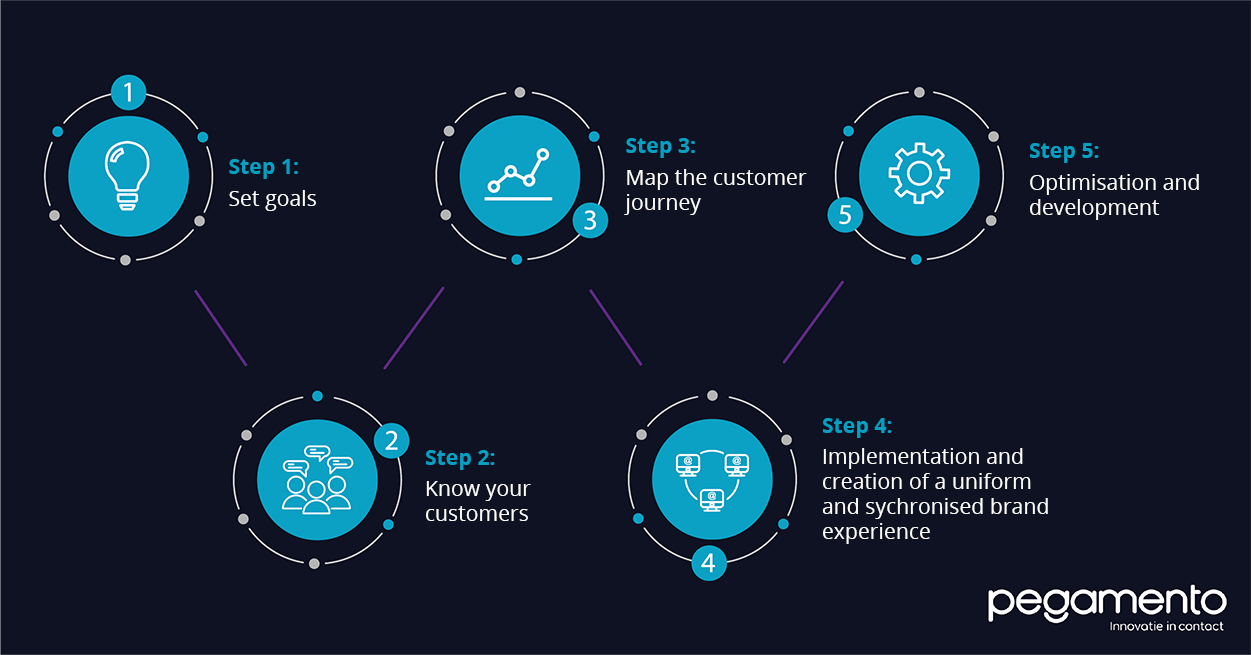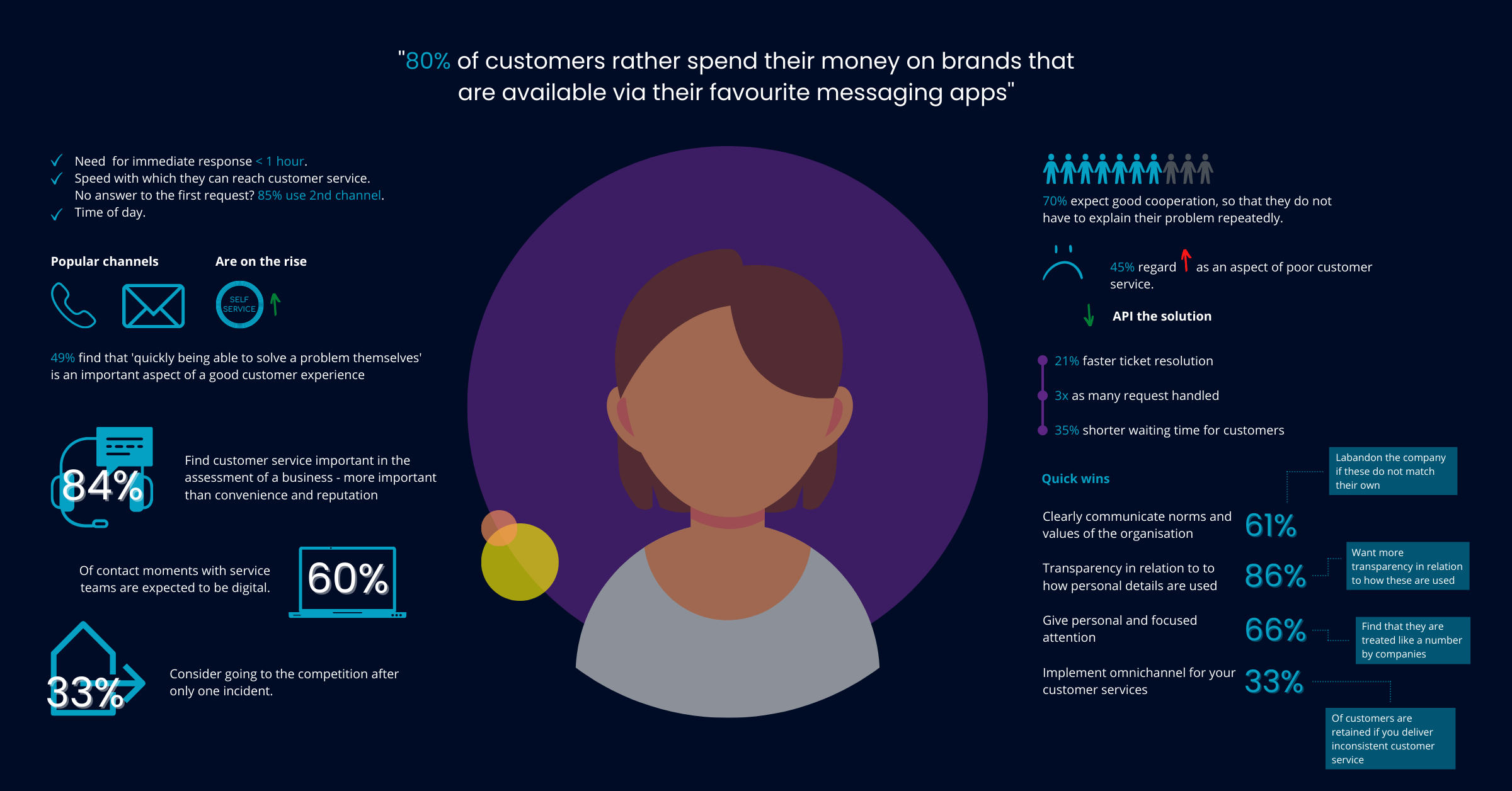Customers decide where, when, and, particularly, how they buy products and services. They browse products, do research, ask questions, make comparisons, make purchases, and return products via the channel that is most convenient for them at the time. They expect there to be multiple roads leading to Rome, or at least to your organisation. And it shouldn't matter which route your customer takes: nothing should interfere with the customer journey, and therefore with the customer experience. So how do you ensure that you are accessible via the channels your customers choose and that there is a consistent brand experience across all those channels? You do this by developing and implementing a perfect omnichannel strategy.
It is not just the use of different channels that shape the customer journey and thus the ultimate customer experience. It's also about the service your organisation provides. Therefore, we have created an infographic outlining a number of trends that you need to take into account when crafting the ultimate omnichannel strategy.
You might also find this article interesting: 5 customer contact trends in contact centres.
What is omnichannel?
First, let's look at what omnichannel actually is. Omnichannel means that different communication channels flow seamlessly into and alongside one another, with the aim of delivering the ultimate customer experience. The customer is the focal point, and it is the customer who makes the choice regarding which channel to use to contact your organisation. With omnichannel, it is important to ensure a uniform and synchronised brand experience across all channels.
Difference between single-, multi-, cross- and omnichannel
Omnichannel? Didn't we already have something like that? In a way, we did, or at least it appeared as if we did. Yet there are a few differences between the various possibilities. There are several different channel strategies you can implement within your organisation. We outline them for you below.
Single channel
With single channel, the customer is presented with one channel. An example here is a physical shop or an online store.
Multichannel
With multichannel, the customer is served via multiple sales channels. These channels can include, for example, a mobile app, physical shop, and online store. The channels are not connected, and often different departments are responsible for each one. Data is not shared across channels, which can lead to differences in pricing, customer experience, brand image, and customer service. For example, with multichannel, customers cannot order a product online and pick it up offline.
Crosschannel
Crosschannel goes a step further than multichannel. Besides being served via multiple sales channels, customers can navigate their journey to purchase through multiple channels. For example, they can orient themselves in the mobile webshop and make the purchase via another channel.
Omnichannel
Omnichannel is practically the same as crosschannel. Except that, as explained in the beginning, all channels flow seamlessly alongside and into one another. All information comes from a single source, and the same pricing and brand experience is present across all channels.
For example, a customer can ask in a bookstore whether a particular book is in stock. If it is not, the salesperson can check whether the book can be delivered to the customer's home the next day. The customer decides to buy the book and provides their name and address. The seller can place the order via the customer's registered account and the customer pays for the book. The book is delivered to the customer's home the next day. The customer can then find the complete order history - including the book they had ordered in the physical store - in their account via the app, desktop, or their mobile phone.

5 steps for creating your omnichannel strategy
Now that we know exactly what omnichannel is, it is time to shape the strategy to create a flawless customer journey and the ultimate customer experience. We do this using the following 5 steps:
Step 1: set your goals
First, determine why you want to implement an omnichannel strategy. For instance, do you want to do this to improve customer loyalty, because you want to increase turnover, or because of some other goal? Make sure your goals are specific and measurable, e.g. via the SMART formula. Only then will you be able to measure whether your omnichannel strategy is having the desired effect.
Step 2: know your customer
Omnichannel only works properly if you know who to target. With this strategy, the entire organisation is structured around the customer's needs. This is because the customers choose the channels that suit their situations and needs, and these differ from moment to moment. The organisation should be designed to serve the customer optimally and also to retain the customer. It is therefore important to analyse your target group as well as possible and to understand its needs. You can do this by creating a persona of your target group: a fictitious person with a detailed description of a user of your product or service.
Step 3: map the customer journey
In a nutshell, the customer journey is the journey the customer takes from the moment the need for a product arises to the moment of purchase and after-sales service. As an organisation, you want to be with the customer from the moment they get the inspiration to satisfy a need by making a purchase. What steps do customers go through in their purchase process? Which channels do they use to obtain information? And via which channels do they arrive at your website, for example?
This way, you get even more information about your customers' behaviour. The idea is also that you align your omnichannel strategy perfectly with this customer journey.
Step 4: implementation and creation of a uniform and synchronised brand experience
The strategy has been envisioned and created. Now it is time to start implementing it. Set up the channels you want to use and create a uniform brand experience. You do this by aligning the content on all channels, adopting the same house style, and evoking the same customer feeling.
The basis for enabling an omnichannel strategy is by integrating all channels into an ERP or CRM system, for example with our Pegamento Contact Center as omnichannel software. This allows you to send and receive all communication via a single location. This ensures that you don't overlook incoming messages. On social media alone, 55% of requests are not followed up.
In addition, all data is collected in a dashboard that provides the necessary insights for steps 1 and 5. Different applications can also be connected and can work together through APIs. This means that you don't need to switch between various screens to search for the right information. Also, all (customer) data is conveniently collected in one place. Nothing is more annoying for a customer than constantly having to share their details or repeat their questions. That puts a real damper on the customer experience.
Step 5: optimisation and development
Now that the omnichannel strategy is in place, you need to keep optimising it. This means collecting data and analysing it. By doing so, you can continue to develop your strategy and improve your results.

The ultimate customer experience with the perfect omnichannel strategy
If you follow the 5 steps, you will create an omnichannel strategy that suits your target audience and your organisation. The foundation involves knowing your target audience and their customer journey. It also involves finding a platform from which you can execute your strategy. By taking these steps, you ensure that your organisation is accessible via multiple paths, all of which provide a uniform and synchronised brand experience. And these are the ingredients for an ultimate customer experience.
Want to know more about a platform for omnichannel integration? Contact our experts for a no-obligation conversation.

